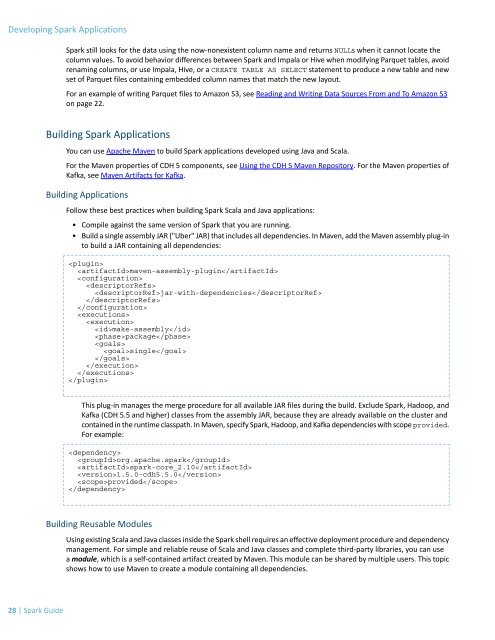cloudera-spark
You also want an ePaper? Increase the reach of your titles
YUMPU automatically turns print PDFs into web optimized ePapers that Google loves.
Developing Spark Applications<br />
Spark still looks for the data using the now-nonexistent column name and returns NULLs when it cannot locate the<br />
column values. To avoid behavior differences between Spark and Impala or Hive when modifying Parquet tables, avoid<br />
renaming columns, or use Impala, Hive, or a CREATE TABLE AS SELECT statement to produce a new table and new<br />
set of Parquet files containing embedded column names that match the new layout.<br />
For an example of writing Parquet files to Amazon S3, see Reading and Writing Data Sources From and To Amazon S3<br />
on page 22.<br />
Building Spark Applications<br />
You can use Apache Maven to build Spark applications developed using Java and Scala.<br />
For the Maven properties of CDH 5 components, see Using the CDH 5 Maven Repository. For the Maven properties of<br />
Kafka, see Maven Artifacts for Kafka.<br />
Building Applications<br />
Follow these best practices when building Spark Scala and Java applications:<br />
• Compile against the same version of Spark that you are running.<br />
• Build a single assembly JAR ("Uber" JAR) that includes all dependencies. In Maven, add the Maven assembly plug-in<br />
to build a JAR containing all dependencies:<br />
<br />
maven-assembly-plugin<br />
<br />
<br />
jar-with-dependencies<br />
<br />
<br />
<br />
<br />
make-assembly<br />
package<br />
<br />
single<br />
<br />
<br />
<br />
<br />
This plug-in manages the merge procedure for all available JAR files during the build. Exclude Spark, Hadoop, and<br />
Kafka (CDH 5.5 and higher) classes from the assembly JAR, because they are already available on the cluster and<br />
contained in the runtime classpath. In Maven, specify Spark, Hadoop, and Kafka dependencies with scope provided.<br />
For example:<br />
<br />
org.apache.<strong>spark</strong><br />
<strong>spark</strong>-core_2.10<br />
1.5.0-cdh5.5.0<br />
provided<br />
<br />
Building Reusable Modules<br />
Using existing Scala and Java classes inside the Spark shell requires an effective deployment procedure and dependency<br />
management. For simple and reliable reuse of Scala and Java classes and complete third-party libraries, you can use<br />
a module, which is a self-contained artifact created by Maven. This module can be shared by multiple users. This topic<br />
shows how to use Maven to create a module containing all dependencies.<br />
28 | Spark Guide




